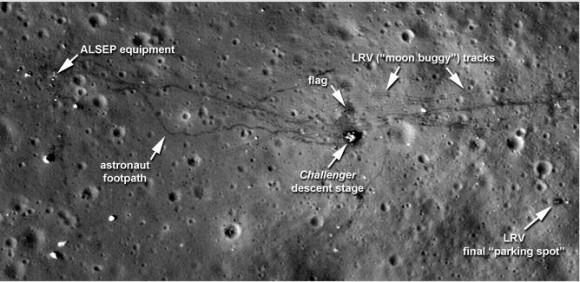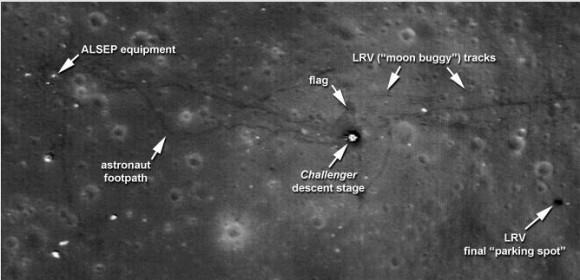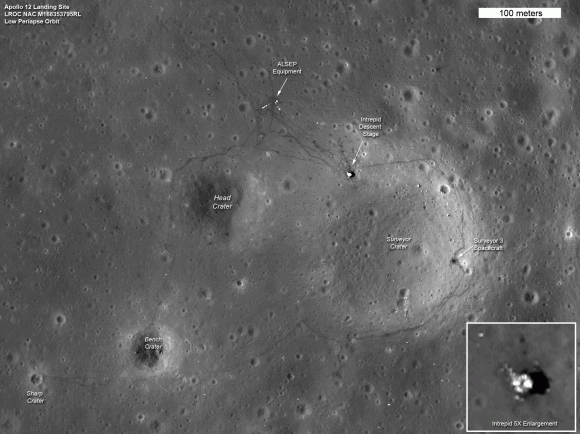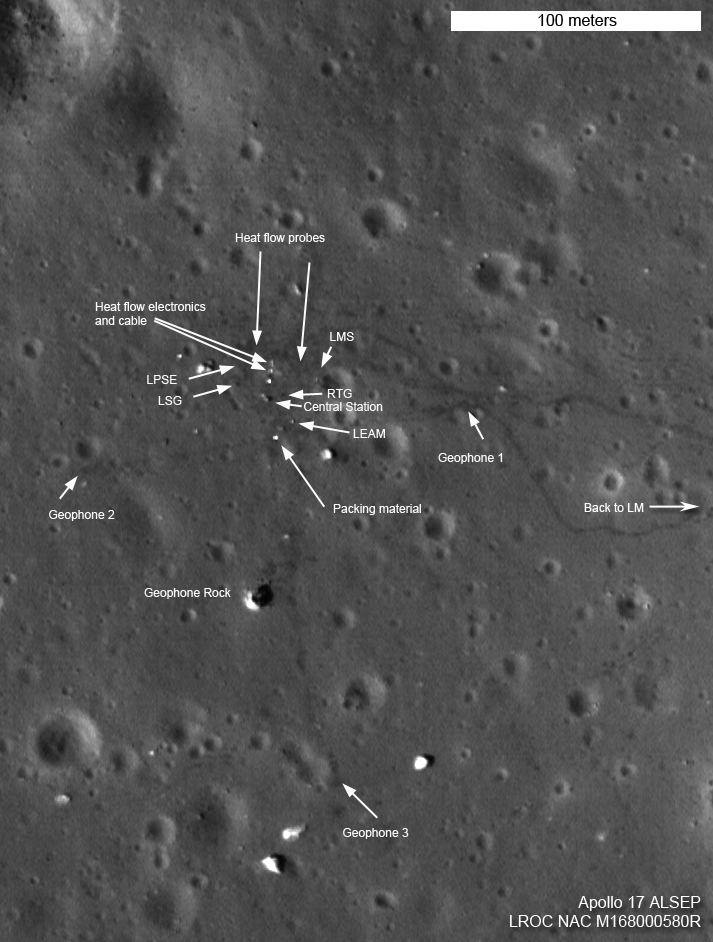[/caption]
New images of the Apollo 12, 14 and 17 landing sites are the highest resolution pictures ever of human forays onto another world, as seen from a bird’s eye view — or in this case, a satellite’s eye view. The Lunar Reconnaissance Orbiter dipped to a lower altitude, just 21 kilometers (13 miles) over the lunar surface.
“We like to look at the Apollo landing site images because it’s fun,” said LRO principal investigator Mark Robinson at a media briefing today. “But LROC (Lunar Reconnaissance Orbiter Camera) is looking at the whole Moon, and we have now taken 1,500 of these very high resolution images from all around the Moon which will help scientists and engineers to plan where we want to go in the future.”


Compare in the images above the Apollo 17 landing site with 25 cm per pixel (top) and 50 cm per pixel (bottom).
Most notable are the tracks where the astronauts walked show up better, and details of the landers/descent stages can be resolved better.
Robinson said he was looking at the new images of the Apollo 17 landing site in Taurus Littrow Valley with Apollo 17 astronaut Jack Schmitt and Schmitt said “You need to image the whole valley at this resolution!”
This is the third resolution of Apollo sites that the LRO team has released — the first came from LRO’s commissioning phase where the altitude was about 100 km and the resolution was about 1 meter per pixel; next came the release of images from an altitude of about 50 km, with a resolution of about 50 cm per pixel; and now from about 21-22 km altitude with a resolution of 25 cm per pixel.
“These are the sharpest images of Apollo landing sites we’ll probably ever get with LRO,” said Rich Vondrak, LRO project scientist, “as we’ll never go as low in altitude as we were in the past month.”
LRO has now returned to its circular orbit of 50 km above the surface. This altitude requires monthly reboosts and since keeping LRO in that orbit would quickly exhaust the remaining fuel, in mid-December, LRO will move to an elliptical orbit, (30 km over south pole and 200 km over north pole). LRO will be able to stay in this orbit for several more years.
“This has been a highly productive mission, releasing a total of 245 terabytes of data — which would be a stack of 52,000 DVDs,” Vondrak said. Next week the science team will put out their 7th public release of data to the Planetary Data System, making all that data available to the public.

Robinson noted that the details of what pieces of equipment are in each location are verified by images taken from the surface by the astronauts. He was asked about the flags and if they are still standing: “All we can really see is the spots where the flag was planted because the astronauts tramped down the regolith. I’m not sure if the flags still exist, given the extreme heat and cold cycle and the harsh UV environment. The flags were made of nylon, and personally I would be surprised if anything was left of them since it has been over 40 years since they were left on the Moon and the flags we have here on Earth fade after they are left outside for one summer. If the flags are still there they are probably in pretty rough shape.”

Since we can still see the tracks and equipment looking unchanged (at least from this vantage point) one reporter asked if these items will be on the Moon forever. “Forever is a long time, so no, they won’t be there forever,” Robinson replied. “The Moon is constantly bombarded by micrometeorites, and slowly over time the tracks will disappear, then the smaller pieces of equipment will disappear, and eventually the decent stages will probably get blasted by an a larger asteroid. The estimate is that rocks erode 1 mm per million years. In human terms it may seems like forever, but geologic terms, there will be no traces of Apollo exploration in 10 to 100 million years.”
This video shows more info and a “zoom in” of the sites:


I love them!
It’s cool that this looks the same as it did 50 years ago. This will serve as an enduring reminder of what mankind can do if we didn’t have greedy bankers and idiot politicians controlling things.
It’s cool that this looks the same as it did 50 years ago. This will serve as an enduring reminder of what mankind can do if we didn’t have greedy bankers and idiot politicians controlling things.
It’s cool that this looks the same as it did 50 years ago. This will serve as an enduring reminder of what mankind can do if we didn’t have greedy bankers and idiot politicians controlling things.
It’s cool that this looks the same as it did 50 years ago. This will serve as an enduring reminder of what mankind can do if we didn’t have greedy bankers and idiot politicians controlling things.
It’s cool that this looks the same as it did 50 years ago. This will serve as an enduring reminder of what mankind can do if we didn’t have greedy bankers and idiot politicians controlling things.
You forgot to mention overpaid shyster lawyers!
You forgot to mention overpaid shyster lawyers!
sorry for the multiple posts, i guess it WAS working, just not showing up. We will now return you to your regularly scheduled comments
The lunar landing sites are certainly worthy of World (off-world) Heritage Site designation. Future missions to the Moon should avoid these “First Peopling” sites as they reprepresnt our very first, tentative attempts at venturing to new worlds. Archaeological sites representing the very first appearance of humans in a specific geographic setting are difficult (or impossible) to establish here on Earth. The lunar landing sites are the only certain example of first peopling in the archaeological record. If NASA needs an archaeologist to do the fieldwork, sign me up!
Naturally, I agree.
However, as an aside, wouldn’t “avoiding” the old landing sites just give the hoaxers some new fuel: “See, they don’t go there, because they don’t want us to find out that we never were there!”
Just sayin’. 😉
No Doc.; ALL (well almost) archaelogical sites are raided and robbed by man. I doubt that these will be any different. At least archaeologists carefully document and map the sites before they remove anything and when the items are removed they are taken to proper places for study and eventually end in a museum for all to enjoy. Most are just robbed though.
Most are robbed by those that claim to be working for a university or museum, they do not display over 99.999% of what they take from where they had no right to take from, it sits on shelving racks and in drawers with coded numbers written on them I should have raided some of their take when I had the chances to..
Apollo has too many things nasa had no legit reason for doing unless, they never went there.
Most are robbed by those that claim to be working for a university or museum, they do not display over 99.999% of what they take from where they had no right to take from, it sits on shelving racks and in drawers with coded numbers written on them I should have raided some of their take when I had the chances to..
Apollo has too many things nasa had no legit reason for doing unless, they never went there.
Sam – what sort of things are you referring to with the line…
> Apollo has too many things nasa had no legit reason for doing
Got me sort of curious.
This assumes there will be subsequent missions to the moon, and enough of them so there are expeditions to the Apollo sites. Curiously, just visiting these sites would introduce new paths in the lunar regolith, which would change these sites. I give the Chinese half a chance of putting astronauts on the moon. Yet I suspect they will perform a number of missions, conclude these ventures are too expensive with little economic return, and cancel their lunar program. China will do this during a period where it rises to a position of largesse, but also where they end up getting mired in world difficulties and expensive ventures — in the American experience think Vietnam and Iraq. The Chinese will doubtless do much the same and tap away their power. I doubt the Chinese will send a mission to the moon in order to explore American lunar sites from the previous century. Robotic and telepresent systems might be used on the moon with greater frequency than astronauts. However, it is unlikely missions will be devoted to probing Apollo sites. Probing these sites is most likely to happen if humans or our robots end up crawling all over the moon at some point in the future.
Prior to the field of archeology most ancient sites were either looted or vandalized. The Egyptian pyramids were constructed with a marble covering, which is still seen on the tops. However, in post-Pharaoh Egypt people stripped this off to fabricate other things. Archeologists do adulterate sites, but at least it is not mindless pillaging or demolition.
LC
Right now, somewhere, there are aliens laughing at us. We got all the way to the Moon, and stopped exploring. We are content to send robots, but not take any risks with courageous astronauts. Now our space program is a mere shadow of what it once was because no president wants to continue with the previous administration’s plans, and instead creates a new plan, and attempts to give an inspirational speech about how it will change the world, unite humanity, etc. But nothing ever happens.
Maybe someday, private companies will get there to exploit resources, but I’m not holding my breath.
Looking at all those craters from small meteorites, whats the chance of some hitting an astronaut’s head ?